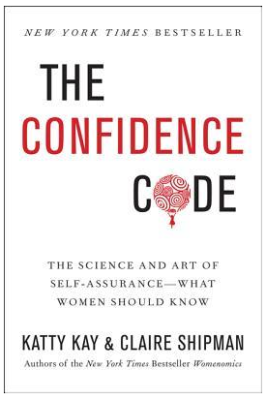The Confidence Code: The Science and Art of Self-Assurance – What Women Should Know
 (May 13, 2014) I think this is singularly one of the most important books written in the last several years. Journalists Katty Kay and Claire Shipman have done an amazing job in both researching this subject and writing about it in a thoughtful and productive way. The Atlantic’s May 2014 cover story entitled “The Confidence Gap” is a great in-depth article based on the research done for this book.
(May 13, 2014) I think this is singularly one of the most important books written in the last several years. Journalists Katty Kay and Claire Shipman have done an amazing job in both researching this subject and writing about it in a thoughtful and productive way. The Atlantic’s May 2014 cover story entitled “The Confidence Gap” is a great in-depth article based on the research done for this book.
I was fortunate to hear the authors speak about their book with James Bennet of The Atlantic at an event held in DC in May 2014. Their research is quite enlightening and their conclusions resonate with me. They manage to boil down the definition of confidence to this: “Confidence is the stuff that turns thoughts into action.” They interviewed many women in positions of leadership to get their assessment of what women need to focus on in order to build confidence. One insight is the fact that women often over-think things where men have a bias to action. Women also tend to be perfectionists – if we don’t think we can do it successfully, we often will not attempt it. This ranges from skipping questions on a test to not applying for a promotion. They remind us that people who succeed aren’t always “naturals” – they are “doers.”
Men and women approach many things differently. Men will make many more attempts at things knowing they will not always be successful but building their resiliency that allows them to bounce back and try again. Women are more cautious. There is a movement in the workplace to make confidence a formal part of the performance review process. Women tend to believe that competence is what makes us successful, when research shows us that confidence is the more critical factor. Confidence sways people. We all give confidence inordinate weight. There is a disparity in the correlation between confidence and competence for men and women: men tend to have an overinflated sense of competence and women tend to underestimate their competence. Greater confidence is what tends to propel men forward and lack of it tends to hold women back.
They posit that “confidence is life’s enabler: professionally, intellectually, athletically, socially and amorously.” It’s a choice we make to act, or to do, or to decide. Confidence is WORK. And women would do well to work at it harder. At the end of the day, and the book, the authors encourage us to “Think less. Take action. Be authentic.”
It would be so beneficial for women to recognize this confidence gap, name it, and understand it’s a common hurdle the vast majority of us deal with every day. We need to push through it and go on and we need to help those around us to do the same.